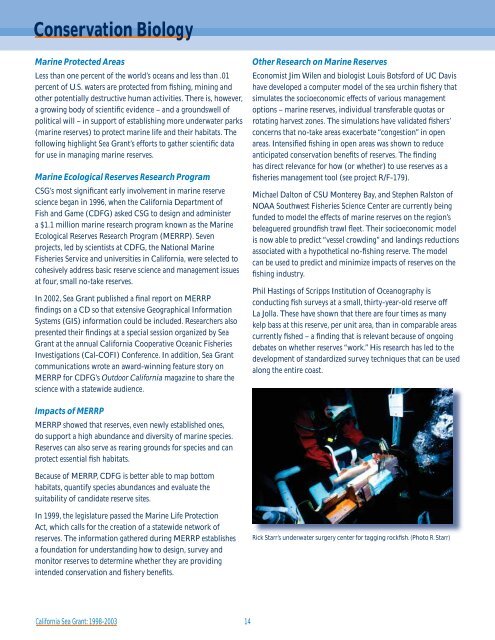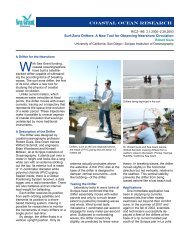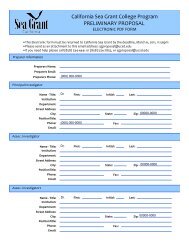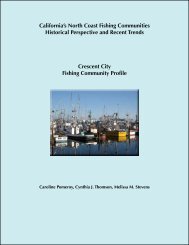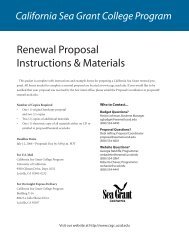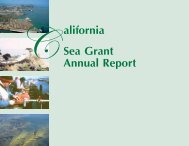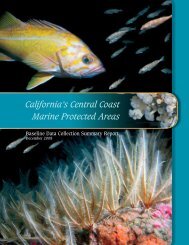PAT-UC Covers - California Sea Grant - UC San Diego
PAT-UC Covers - California Sea Grant - UC San Diego
PAT-UC Covers - California Sea Grant - UC San Diego
You also want an ePaper? Increase the reach of your titles
YUMPU automatically turns print PDFs into web optimized ePapers that Google loves.
Conservation Biology<br />
Marine Protected Areas<br />
Less than one percent of the world’s oceans and less than .01<br />
percent of U.S. waters are protected from fishing, mining and<br />
other potentially destructive human activities. There is, however,<br />
a growing body of scientific evidence – and a groundswell of<br />
political will – in support of establishing more underwater parks<br />
(marine reserves) to protect marine life and their habitats. The<br />
following highlight <strong>Sea</strong> <strong>Grant</strong>’s efforts to gather scientific data<br />
for use in managing marine reserves.<br />
Marine Ecological Reserves Research Program<br />
CSG’s most significant early involvement in marine reserve<br />
science began in 1996, when the <strong>California</strong> Department of<br />
Fish and Game (CDFG) asked CSG to design and administer<br />
a $1.1 million marine research program known as the Marine<br />
Ecological Reserves Research Program (MERRP). Seven<br />
projects, led by scientists at CDFG, the National Marine<br />
Fisheries Service and universities in <strong>California</strong>, were selected to<br />
cohesively address basic reserve science and management issues<br />
at four, small no-take reserves.<br />
In 2002, <strong>Sea</strong> <strong>Grant</strong> published a final report on MERRP<br />
findings on a CD so that extensive Geographical Information<br />
Systems (GIS) information could be included. Researchers also<br />
presented their findings at a special session organized by <strong>Sea</strong><br />
<strong>Grant</strong> at the annual <strong>California</strong> Cooperative Oceanic Fisheries<br />
Investigations (Cal-COFI) Conference. In addition, <strong>Sea</strong> <strong>Grant</strong><br />
communications wrote an award-winning feature story on<br />
MERRP for CDFG’s Outdoor <strong>California</strong> magazine to share the<br />
science with a statewide audience.<br />
Other Research on Marine Reserves<br />
Economist Jim Wilen and biologist Louis Botsford of <strong>UC</strong> Davis<br />
have developed a computer model of the sea urchin fishery that<br />
simulates the socioeconomic effects of various management<br />
options – marine reserves, individual transferable quotas or<br />
rotating harvest zones. The simulations have validated fishers’<br />
concerns that no-take areas exacerbate “congestion” in open<br />
areas. Intensified fishing in open areas was shown to reduce<br />
anticipated conservation benefits of reserves. The finding<br />
has direct relevance for how (or whether) to use reserves as a<br />
fisheries management tool (see project R/F-179).<br />
Michael Dalton of CSU Monterey Bay, and Stephen Ralston of<br />
NOAA Southwest Fisheries Science Center are currently being<br />
funded to model the effects of marine reserves on the region’s<br />
beleaguered groundfish trawl fleet. Their socioeconomic model<br />
is now able to predict “vessel crowding” and landings reductions<br />
associated with a hypothetical no-fishing reserve. The model<br />
can be used to predict and minimize impacts of reserves on the<br />
fishing industry.<br />
Phil Hastings of Scripps Institution of Oceanography is<br />
conducting fish surveys at a small, thirty-year-old reserve off<br />
La Jolla. These have shown that there are four times as many<br />
kelp bass at this reserve, per unit area, than in comparable areas<br />
currently fished – a finding that is relevant because of ongoing<br />
debates on whether reserves “work.” His research has led to the<br />
development of standardized survey techniques that can be used<br />
along the entire coast.<br />
Impacts of MERRP<br />
MERRP showed that reserves, even newly established ones,<br />
do support a high abundance and diversity of marine species.<br />
Reserves can also serve as rearing grounds for species and can<br />
protect essential fish habitats.<br />
Because of MERRP, CDFG is better able to map bottom<br />
habitats, quantify species abundances and evaluate the<br />
suitability of candidate reserve sites.<br />
In 1999, the legislature passed the Marine Life Protection<br />
Act, which calls for the creation of a statewide network of<br />
reserves. The information gathered during MERRP establishes<br />
a foundation for understanding how to design, survey and<br />
monitor reserves to determine whether they are providing<br />
intended conservation and fishery benefits.<br />
Rick Starr’s underwater surgery center for tagging rockfish. (Photo R. Starr)<br />
<strong>California</strong> <strong>Sea</strong> <strong>Grant</strong>: 1998-2003<br />
14


